Abstract
Global fossil fuel reserves are declining due to differential uses, especially for power generation. Everybody can help to do their bit for the environment by using solar energy. Geographically, Bangladesh is a potential zone for harnessing solar energy. In March 2021, the renewable generation capacity in Bangladesh amounted to 722.592 MW, including 67.6% from solar, 31.84% from hydro, and 0.55% from other energy sources, including wind, biogas, and biomass, where 488.662 MW of power originated from over 6 million installed solar power systems. Concurrently, over 42% of rural people still suffer from a lack of electricity, where solar energy can play a vital role. This paper highlights the present status of various forms of solar energy progress in Bangladesh, such as solar parks, solar rooftops, solar irrigation, solar charging stations, solar home systems, solar-powered telecoms, solar street lights, and solar drinking water, which can be viable alternative sources of energy. This review will help decision-makers and investors realize Bangladesh’s up-to-date solar energy scenario and plan better for the development of a sustainable society.
1. Introduction
Energy is the basis for the survival and development of human life and plays a vital role in a nation’s national economic growth and security [1]. No country can be able to promote and sustain its development in the absence of the proper use of energy. Any energy imbalance regarding demand and supply can jeopardize the functioning of a nation, mostly in developing countries [2]. As civilization progresses from modern to ultramodern, the world’s energy demand is rising [3], which is the primary cause of global energy issues and is assumed to increase by about five times by 2100 [4]. Every moment of the day, we are using more and more energy due to technological advancements [5], high demand [6], and, in some cases, extravagant consumption of electrical and electronic gadgets.
Natural gas, coal, and petroleum are generally denoted as fossil fuels [7]. Typically, electricity is generated by the burning of fossil fuels [8], and roughly 75% (three-quarters) [9] of global energy is fossil-based, emitting a lot of greenhouse gases [10] into the atmosphere. Furthermore, it has been estimated that all global fossil fuels will be wholly depleted within a few decades and that these sources are limited and quickly becoming costly and rare [11]. Therefore, many countries are shifting partially to renewable sources to meet their energy needs [12]. According to REN21, by the end of 2019, the world’s renewable alternative energy generation capacity reached 2838 GW [13]. Therefore, to deal with the energy challenge, there is no alternative option without renewable energy sources. Renewable energy is an alternative energy that could assist in reducing fossil fuel demand and play a significant role in the country’s energy security [14]. In Bangladesh, solar, wind, hydro, and biomass energy are the primary traditional renewable energy sources, and solar energy has the utmost potential among them [15]. For many nations [16], solar energy is the most attractive alternative energy source among all other renewables.
Bangladesh is the world’s eigth most populated country, with a population of 165.88 million [17] and a population density of 1278 persons/km2 [18]. In urban areas, a maximum of 94.1% of the population has access to electricity [19]. However, 79% and 60% of consumers face low voltage supply and load-shedding [20]. Electrification rates have been improving in recent years because of the rapid progress of grid connection and the insertion of various solar energy projects in rural parts of the country. In March 2021, around 6.02 million solar home systems [21] were mounted on Bangladesh’s off-grid spaces, benefiting more than 20 million rural people [22].
According to BPDB, the present growth rate of yearly electricity demand is about 10%, which will probably be higher in the future due to population growth, technological and economic advancements, and continual GDP growth [23]. In the fiscal years 2020–21, 67.71% of electricity was generated from domestic sources (60.19% from natural gas, 6.21% from coal, 0.81% from hydro, and 0.20% from other renewables), 22.52% from imported petroleum fuels (21.76% from furnace oil and 0.76% from diesel), and 10.08% of power was imported [24]. The energy used in domestic, industrial, commercial, agricultural, and other sectors was 56.42%, 28.40%, 10.58%, 2.43%, and 2.16%, respectively, in the year 2020–21.
The total electricity generation in 2019–20 was 71,419 GWh (49.45% from the public sector, 41.20% from the private sector, and 9.35% imported), which was only 1.26% higher than the previous year’s net generation due to COVID-19 [25]. In 2018–19, the total electricity generation was 70,533 GWh [26], 12.53% higher than the previous year’s net generation of 62,678 GWh [27]. The per capita electricity generation in 2019–20 was 426.23 KWh [28]. According to the updated Power Sector Master Plan (PSMP) 2016, the electricity generation capacity requirements in 2021, 2030, and 2041 will be 21,000 MW, 31,000 MW, and 57,000 MW [29] against the demand of 14,500 MW, 27,400 MW, and 51,000 MW [30].
Approximately 770 million people live without access to electrical power, mainly in Africa and Asia [31]. Over the past decade, Bangladesh has been experiencing a significant shortage of electricity [32]. The current energy production in Bangladesh has not satisfied the power requirements in the industrial, agricultural, and residential sectors, which are the leading causes of severe load shading, less production, and food insecurity [33]. Insufficient energy also leads to income losses, decreased capital formation, reduced exports, and slow economic growth [34]. Hence, the energy issue of the country is a hot topic to meet the sustainable energy demand of the future. Therefore, the government needs to continue searching for viable alternative energy sources, and renewables could be an alternative source. Energy is the main driving force for Bangladesh’s development and plays a dynamic role in achieving Vision-2021, Vision-2041, and succeeding SDGs [35]. In continuation, the GoB, with other private organizations, is attempting to reach the target and taking the initiative to generate electricity from renewable sources in the future, including solar, wind, biogas and biomass energy, etc.
The vision of 2041 will not be possible if energy security cannot be assured. Scientists have been working to mitigate the energy crisis by finding alternate energy sources. The most distinguished researchers claim that the energy crisis of Bangladesh could be solved through renewable solar power along with other RE and conventional nonrenewable energy sources, as shown in Table 1. This paper highlights the present status of various forms of solar energy progress in Bangladesh, such as solar parks, solar rooftops, solar irrigation, solar charging stations, solar home systems, solar-powered telecoms, solar street lights, and solar drinking water, which can be viable alternative sources of energy.

Table 1.
Existing research works related to solar energy in Bangladesh.
Table 1.
Existing research works related to solar energy in Bangladesh.
| Author | Publication Year | Title of Paper | References |
|---|---|---|---|
| Mondal et al. | 2010 | Assessment of renewable energy resources’ potential for electricity generation in Bangladesh | [1] |
| Bagalini et al. | 2019 | Solar PV-Battery-Electric Grid-Based Energy System for Residential Applications: System Configuration and Viability | [3] |
| Asif and Muneer | 2007 | Energy supply, its demand, and security issues for developed and emerging economies | [4] |
| Halder et al. | 2015 | Energy scarcity and potential of renewable energy in Bangladesh | [5] |
| Ahmed | 2014 | Exploitation of renewable energy for sustainable development and overcoming power crisis in Bangladesh | [6] |
| Ahiduzzaman and Islam | 2011 | Greenhouse gas emissions and renewable energy sources for sustainable development in Bangladesh | [8] |
| Islam et al. | 2014 | A Study of Solar Home System in Bangladesh: Current Status, Future Prospects, and Constraints | [33] |
| Jacobson | 2007 | Connective Power: Solar Electrification and Social Change in Kenya | [36] |
| Ugli | 2019 | The Importance of Alternative Solar Energy Sources and the Advantages and Disadvantages of Using Solar Panels in this Process | [37] |
| Dincer | 2011 | The analysis on photovoltaic electricity generation status, potential and policies of the leading countries in solar energy | [38] |
| Shaikh | 2017 | A Review Paper on Electricity Generation from Solar Energy | [39] |
| Amin et al. | 2014 | Solar Home System in Bangladesh: Prospects, Challenges, and Constraints | [40] |
| Islam et al. | 2008 | Renewable energy resources and technologies practised in Bangladesh | [41] |
| Islam et al. | 2017 | Prospect and advancement of solar irrigation in Bangladesh: A review | [42] |
| Hossain et al. | 2015 | Technical and economic feasibility of solar pump irrigations for an eco-friendly environment | [43] |
| Bhattacharyya | 2015 | Mini-grid-based electrification in Bangladesh: Technical configuration and business analysis | [44] |
| Chowdhury et al. | 2011 | Technical appraisal of solar home systems in Bangladesh: A field investigation | [45] |
| Hoque and Das | 2013 | Present status of solar home and photovoltaic micro utility systems in Bangladesh and recommendation for further expansion and upgrading for rural electrification | [46] |
A review was conducted with the aim of showing the different forms of solar energy progress in Bangladesh. The review was applied with the following conditions:
- Sources: Only original research papers and review articles from indexed international journals and international conference proceedings from prestigious international organizations.
- Language: English only.
- Publication period: Only research works published in the period from 2003 to 2022 were considered.
- Requirements: Selected contributions must be open access or available in international databases and must be peer-reviewed, guaranteeing traceability in the research.
The literature review was conducted through PubMed, Scopus, and Google scholar. The results are shown in Table 2. In total, 694 references were reviewed; 56% were journaled articles, 35% were review articles, and 9% were conference papers.

Table 2.
Review works related to different forms of solar energy in Bangladesh.
This study mainly explores the status of renewable energy in Bangladesh and the potential for RE to be set up all over the country. The data and information were collected, processed, and epitomized from official published reports of several international and domestic energy organizations. The main reports used as references in this study are listed below:
- (a)
- Renewables Global Status Reports (2020) by the Renewable Energy Policy Network for the 21st Century (REN 21) [13].
- (b)
- Bangladesh Bureau of Statistics (BBS):
- i.
- Bangladesh Statistics 2017 [19];
- ii.
- Statistical Pocketbook 2019 [28];
- iii.
- 2016 Statistical Year Book Bangladesh [47];
- iv.
- BBS. Gross Domestic Product (GDP) of Bangladesh 2018–19 [48].
- (c)
- Sustainable and Renewable Energy Development Authority (SREDA). Ministry of Power, Mineral and Energy Resources [21].
- (d)
- Bangladesh Power Development Board (BPDB):
- i.
- Annual Report 2019–2020 of BPDB 2020 [23];
- ii.
- Annual Report 2020–2021 of BPDB 2021 [24];
- iii.
- Annual Report 2018–2019 of BPDB 2019 [27].
- (e)
- Power System Master Plan (PSMP) by the Government of the People’s Republic of Bangladesh [25].
- (f)
- Hydrocarbon Unit (HCU), Energy and Mineral Resources Division, Ministry of Power, Energy and Mineral Resources [26].
- (g)
- World Energy Resources: Solar. World Energy Council 2013 [49].
- (h)
- Bangladesh Meteorological Department (BMD). Ministry of Defense of the Government of Bangladesh [50].
- (i)
- The International Renewable Energy Agency (IRENA):
- i.
- Trends in Renewable Energy. IRENA [51];
- ii.
- Solar energy. IRENA [52].
- (j)
- Globalsolaratlas [53].
The remaining parts of the article are arranged into seven sections. Section 2 describes the global renewable energy scenario and the current RE scenario of Bangladesh. Section 3 presents the Solar energy scenario from both international and Bangladesh perspectives. Section 4 explains the geographic vs. photovoltaic power potential of Bangladesh. Section 5 describes the present status of various forms of solar energy progress in Bangladesh, such as solar parks, solar rooftops, solar irrigation, solar grid systems, solar charging stations, solar-powered telecoms, solar home systems, solar street lights, and solar drinking water. Section 6 explains the importance of solar energy (an eco-friendly energy source and sustainability) by calculating the CO2 emission reduction. Finally, the paper closes with the conclusion.
2. Renewable Energy Scenario
2.1. Global Renewable Energy Scenario
The global population and financial progress will lead to approximately 30% additional energy consumption due to achieving Sustainable Development Goals by 2030. In this situation, RE can play a vital role. According to the International Energy Agency (IEA), excluding traditional solid biomass, the share of modern RE will rise from 14% to 19% of global overall energy demand by 2040 [25]. In many countries, such as Kenya [43], China, India, Indonesia, South Africa, etc., RE sources such as solar grid electrification have become an alternative due to technological advancement [36]. In 2017, roughly one-fourth of global electricity was produced from renewables [54].
At the end of 2020, the global total renewable generation capacity amounted to 2838 GW, including 41.21% (1170 GW) from hydropower (the largest share of the global total), 26.77% (760 GW) from solar, 26.17% (743 GW) from wind, and 5.10% from other renewables (such as 145 GW from bioenergy, 14.1 GW from geothermal, 6.2 GW from concentrating solar thermal power (CSP), and 500 MW of marine energy), as shown in Figure 1. The previous year’s generation capacity was 2588 GW [55]. During the year 2020, renewable generation capacity additions were 256 GW, in which solar, wind, and hydropower continued to lead the capacity expansion, with an increase of 139 GW (+54%), 93 GW (+36%), and almost 20 GW (+7%). The remaining capacity was added from bioenergy, geothermal, and CSP with an increase of 4 GW (+1%) [13]. Solar and wind energy jointly continued to lead renewable capacity increases of approximately 87% of all net renewable additions. However, the very low expansion of hydropower last year was due to the unusually high share of solar and wind energy. The historical global renewable generation capacity is shown in Figure S1.
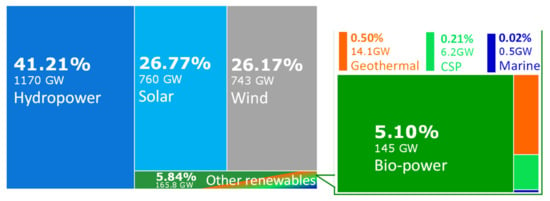
Figure 1.
Global renewable generation capacity by energy in 2020 (authors’ creation based on ref. [13]).
2.2. Present-Day Renewable Energy Scenario in Bangladesh
Since natural gas, coal, and oil are depleting fast, the government has devised significant policies to improve the renewable power sector as part of the power generation program together with traditional nonrenewable energy sources. In 2008, the Ministry of Power, Energy, and Mineral Resources (MoPEMR) established a strategy for renewable energy and set a target for generating RE resources to meet 5, 10, and 100% of the total power demand by 2015, 2020, and 2050, respectively [25]. The demand for energy can be satisfied by exploiting renewable sources. To achieve the target, the GoB has already taken logical steps in both public and private sector investment [23]. According to the policy, the GoB has produced 648.134 MW of RE to date [21]. The GoB has set a target to generate 1676 MW of solar power by 2021, as shown in Table 3.

Table 3.
Targets of renewable energy installed capacity in Bangladesh by 2021 [13].
The current electricity generation mix of Bangladesh and the current status of renewable generation capacity in Bangladesh are shown in Figure 2 and Figure 3. In July 2021, 45.08% of electricity was generated from natural gas, 24% from HFO, 5.12% from HSD, 3.04% from renewable, 11.11% from captive, 7.02 % from coal, and 4.60% was imported. Currently, RE has a very small share of roughly 3.04% of the total national electricity production. The total renewable generation capacity amounts to 766.49 MW, including 69.50% (532.5 MW) from solar, 30% (230 MW) from hydro, and 0.52 (3.99 MW) from others, including 2.9 MW (0.37%) from wind, 0.69 MW (0.09) from biogas, and 0.4 MW (0.05%) from biomass. Table 4 shows the current status of installed RE capacity from diverse sources in Bangladesh.

Table 4.
Present status of installed RE (completed and running) capacity from diverse sources in Bangladesh (authors creation based on SREDA data [21]).
Table 4.
Present status of installed RE (completed and running) capacity from diverse sources in Bangladesh (authors creation based on SREDA data [21]).
| Resource | Technology | Quantity | Off-Grid Capacity (MW) | On-Grid Capacity (MW) | Total Capacity (MW) | Capacity (%) |
|---|---|---|---|---|---|---|
| Solar | Solar Park | 7 | 0 | 130.23 | 130.23 | |
| Rooftop Solar Except NEM | 114 | 14.201 | 25.128 | 39.329 | ||
| Net Metering Rooftop Solar | 1395 | 0 | 24.739 | 24.739 | ||
| Solar Irrigation | 2127 | 44.262 | 0.027 | 44.289 | ||
| Solar Home System | 6,023,632 | 262.75 | 0 | 262.753 | ||
| Solar Minigrid | 27 | 5.656 | 0 | 5.656 | ||
| Solar Microgrid | 0 | 0 | 0 | 0 | ||
| Solar Nanogrid | 2 | 0.001 | 0 | 0.001 | ||
| Solar Charging Station | 14 | 0.266 | 0.016 | 0.282 | ||
| Solar Street Light | 296,861 | 17.065 | 0 | 17.065 | ||
| Solar Powered Telecom BTS | 1933 | 8.06 | 0 | 8.06 | ||
| Solar Drinking Water System | 82 | 0.095 | 0 | 0.095 | ||
| Total Solar | 6,326,194 | 532.5 | 69.5% | |||
| Wind | All wind projects | 3 | 2 | 0.9 | 2.9 | 0.37% |
| Hydro | All hydro projects | 1 | 0 | 230 | 230 | 30% |
| Biogas | Biogas to electricity | 7 | 0.69 | 0 | 0.69 | 0.09% |
| Biogas plant | 83,431 | 0 | 0 | 0 | 0% | |
| Biomass | Biomass to electricity | 1 | 0.4 | 0 | 0.4 | 0.05% |
| Total | 6,409,637 | 355.45 | 411 | 766.489 | 100% | |

Figure 2.
Current electricity generation mix in Bangladesh (authors’ creation based on SREDA [21] data).
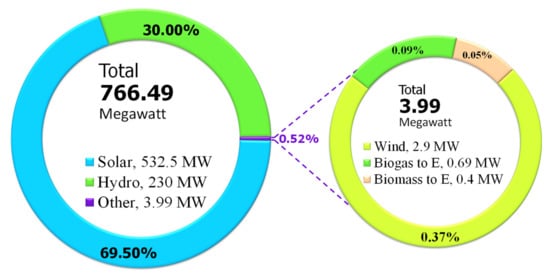
Figure 3.
Current status of renewable generation capacity in Bangladesh (authors’ creation based on SREDA data [21]).
3. Solar Energy Scenario
Solar energy is an infinite energy resource and is environmentally friendly, clean, green, and is not considered destructive to both plants and animals [37]. In our solar system, the almighty creator creates the sun for all energy sources. Approximately 99.99% of energy comes from the sun, where our planet earth provides only 0.01% [56], and the earth receives 89 PW of solar energy [57]. The sun radiates roughly 3.8 × 1023 kW of energy per second. Approximately 60% (1.08 × 1014 kW) of this volume touches the earth’s surface, and the remaining 40% is returned to space. If only 0.1% of this energy could be transformed with 10% efficiency, it could fulfil global energy consumption four times more [49]. It is estimated that the sun could emit energy of about 450 EJ, which is comparable to 7500 times greater than the present global energy demand [38].
3.1. Global Solar Energy Scenario
In the present world, solar energy is regarded as one of the cheapest and highest potential RE sources where the sun provides energy free of cost and with lower manpower needs than other conventional renewables [39]. Day by day, the demand for solar PV is increasing and shows the best viable alternative choice for power generation. It is evident that, in 2020, the total capacity of on-grid and off-grid solar PV in the world was 760 GW, whereas in 2009, just 11 years before, the world’s total capacity was only 23 GW. Around 115 GW of solar PV was added globally in 2020 [13].
According to ref. [13], China alone constituted 35% (48.2 GW), the highest capacity, whereas the United States added 14% (19.2 GW) of solar energy. Japan placed third globally, adding approximately 6% (8.2 GW), followed by Germany at 4% (4.9 MW), India at 3% (4.4 GW), Australia at 3% (4.1 GW), Korea at 3% (4.1 GW), Brazil at 2% (3.1 GW), and the Netherlands at 2% (3.0 GW). The rest of the world’s countries added roughly 21% (28.7 GW).
3.2. Present-Day Solar Energy Scenario in Bangladesh
In Bangladesh, one in five people lives below the poverty line [58], whereas almost one in four Bangladeshi were poor in 2016, just four years ago [59]. Most of these people live in remote areas, making it a challenge to provide them grid electricity; furthermore, as customers are few in number somewhere. For this reason, GoB has fixed a target to provide electricity to all by 2020 and is encouraging people to accept solar energy [5]. As a result, in rural off-grid areas, people have accepted solar photovoltaic (PV) systems wholeheartedly because of the convenience of supplying electricity to households and small businesses. Now, rural off-grid consumers and every grid-connected consumer and commercial or industrial consumer are gaining the benefits of solar energy. They can utilize solar energy by the grace of the installation of different forms of solar cells on their own land or roofs, meeting their demand by themselves and can even sell excess electricity to national grids. In rural areas, there are approximately 20 million people who can now access electricity at night for work, studying, and running small businesses due to solar energy [60].
In 2017, Bangladesh experienced amazing success in the renewable energy sector as it took its place in the top six countries by renewable energy power and secured second position jointly with Mongolia by accessing 8% of power from off-grid solar energy systems, while Nepal was in the first position [13]. The historical solar energy installed capacity and electricity generation in Bangladesh are shown in Figure 4.

Figure 4.
Historical solar energy installed capacity and electricity generation in Bangladesh [41].
4. Geographic vs. Photovoltaic Power Potential of Bangladesh
Bangladesh is a single state with low-lying plain land (except the hilly southeast), mainly riverine and densely populated [61], and is a tropical to subtropical country located in Southeast Asia [62]. It covers 20°34′ N to 26°38′ N latitude and 88°01′ E to 92°41′ E longitude [40]. The area of the country is 147,570 sq. km [41] (56,977 sq. miles) and is bordered by India to the east, north, and west, Myanmar to the southeast, and the Bay of Bengal to the south [63]. Bangladesh relishes a significant volume of sunshine [64] and the usage of solar energy continues to grow, whereas the cost of solar equipment continues to decline. The geographical location and the photovoltaic power potential of Bangladesh are shown in Figure 5.

Figure 5.
Geographical location and the photovoltaic power potential map of Bangladesh [53].
In Bangladesh, due to its geographical position, for most of the year, sunlight is abundant for harnessing solar power [65]. The monthly average bright sunshine hours and average cloud coverage, from 2014 to 2018, in eight divisional districts of Bangladesh are presented in Figure 6. From March to April, extreme solar emission takes place, and minimum radiation is experienced from December to January [5]. The amount of energy available is high, about 4.0 to 6.5 kWh/m2/day, and the sunny daylight hours fluctuate from 6 to 9 h/day, almost 300 days per annum, excluding cloud, rainfall, and fog, which is enough to meet the sunlight requirement for solar energy [66].

Figure 6.
Average bright sunshine hour and cloud coverage in eight divisions of Bangladesh (2014–2018) (authors’ creation based on BMD purchased data [50]).
5. Forms of Solar Energy in Bangladesh
In Bangladesh, solar energy is produced in different forms namely, solar parks, solar rooftops, solar irrigation, solar grids (mini-grids, micro-grids, pico-grids, and nano-grids), solar charging stations, solar-powered telecom BTS, solar home systems, solar street lights, and solar drinking water. Figure 7 presents a snapshot of the diverse solar energy of Bangladesh.
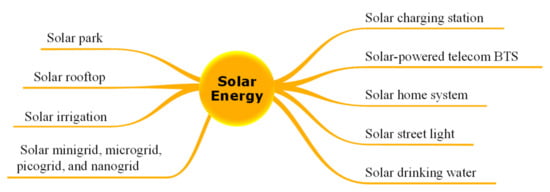
Figure 7.
Overview of solar energy resources (authors’ creation).
Generally, the reliability, safety, performance, and package life of solar PV depend on the design of the plant, the quality of the components used, expertise in installation, and finally, operation and maintenance [67]. Several parameters which affect the forms of solar energy progress are geographical location, weather conditions, land space, high installation costs for poor people, etc. Dust, clouds, and defective/fractured PV cells such as snail tracks, cell crack, hot spots, ethylene vinyl acetate (EVA) discolouration, PV cell fractures, busbar discolouration, bubbles, Si discolouration, etc. also affect the production of solar energy [68]. Improving performance by reducing maintenance and operating costs has turned out to be an important factor in increasing the competitiveness of photovoltaic (PV) systems [69]. Although there are some drawbacks, in the long run, solar energy is green, clean, and eco-friendly.
The solar projects in Bangladesh are divided into three phases such as (i) project completed and running, (ii) project implementation ongoing, and (iii) project under planning, as shown in Table 5. Now, in March 2021, Bangladesh is producing 722.592 MW of power from RE sources, of which 488.662 MW of power originates from over 6 million (6,325,155) installed solar power systems (Figure 8 and Table 5). Concurrently, over 42% of rural people still suffer from a lack of access to electricity [31]. Approximately 569.496 MW with 108 solar systems are under the ongoing implementation phase, and around 1257.813 MW with 21 solar systems are under the planning phase (Figure 9 and Figure 10 and Table 5). Some projects (37 systems with a capacity of 200.28 MW) are rejected from the planning phase. After rejection, the continuing net total proposed amount of solar energy (including i, ii, and iii) is 2315.97 MW with 6,325,284 systems (Table 5).

Table 5.
Solar energy projects in Bangladesh (authors’ creation based on SREDA data [21]).
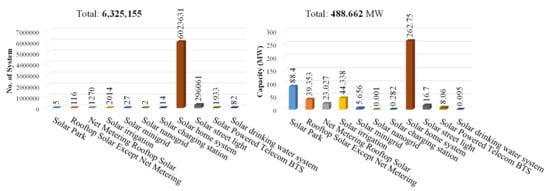
Figure 8.
Solar project completed and running, number of systems, and capacity (authors’ creation based on SREDA data [24]).
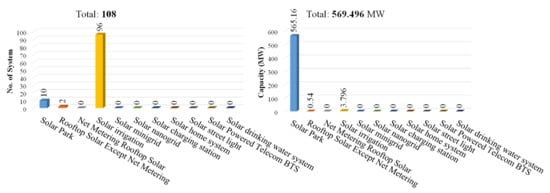
Figure 9.
Solar project implementation ongoing, number of systems, and capacity (authors’ creation based on SREDA data [21]).
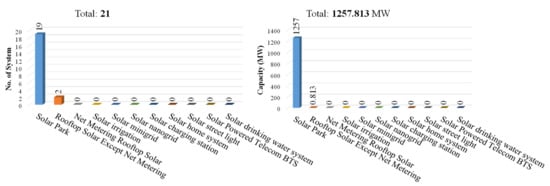
Figure 10.
Solar project under planning, number of systems, and capacity (authors’ creation based on SREDA data [21]).
Various development organizations, including World Bank, along with other private sectors, are working with the government to generate solar energy in Bangladesh. There are approximately 125 stakeholder companies of RE in Bangladesh, creating one of the world’s biggest domestic solar power projects. Among them, BPDB, BREB, IDCOL, MoDMR, RDCD, EGCB, etc., are mentionable and have been engaged in commercializing solar power in rural irrigation, domestic, and commercial sectors.
5.1. Solar Parks
Solar parks, also known as solar farms, are a group of co-located solar power plants [70]. They represent a concentrated area of large-scale solar power generation projects, similar to natural gas-based electricity generation stations [71]. Unlike solar home systems, solar parks are typically made up of ground-fixed solar panels over large areas [72].
To reduce addiction to fossil fuels with the purpose of power generation, the GoB has already started a grid-connected solar-based power generation project named ‘solar park’ where no battery backup is desired. Currently, 5 systems (capacity 88.4 MW) are running, 11 systems (565.16 MW) are in the ongoing implementation phase, 19 systems (1257 MW) are under planning phase (Figure 8, Figure 9 and Figure 10), and 2 systems (200 MW) were rejected from the planning phase (Table 5). After rejection from the planning phase, the net generation capacity remains at approximately 1910.56 MW (Table 5), and more explorations are ongoing. The historical net installed capacity of solar parks in Bangladesh is shown in Figure 11.
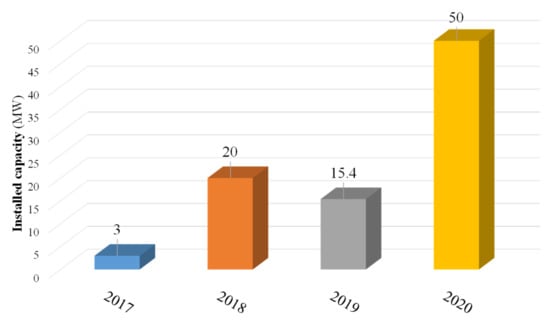
Figure 11.
Historical yearly net installed capacity of solar park in Bangladesh (authors’ creation based on SREDA data [21]).
In Bangladesh, the largest solar park (capacity of 50 MW) was constructed in Gauripur, Mymensingh, with a total of 173,000 solar panels and 332 inverters (to convert the output from direct to alternating current), as shown in Figure 12. The plant was constructed by HDFC SinPower Ltd., under BPDB, which supports meeting the government’s goal of producing 10% of the country’s total electricity using RE by 2021.
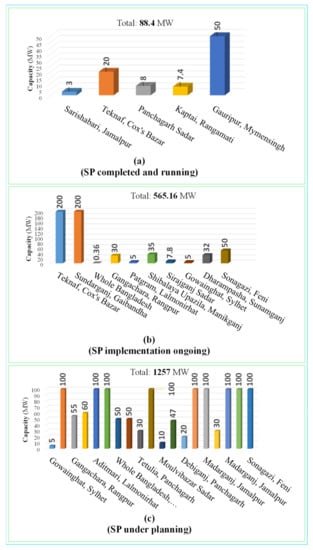
Figure 12.
Present status of solar parks (SP): (a) SP completed and running, (b) SP implementation ongoing, and (c) SP under planning (authors’ creation based on SREDA data [21]).
Site selection is an important matter for building large-scale solar parks, as Bangladesh is a highly populated country with a limited amount of land. For this reason, the GoB has targeted two categories of land for setting up solar parks, those that are Govt. owned unutilized non-agricultural lands or open spaces and others are privately owned lands. The implementing agencies of solar parks are BPDB, EGCB, NWPGCL, B-R PowerGen, APSCL, and RPCL. Figure S2 shows the largest solar park in Gauripur, Mymensingh district, Bangladesh [73].
5.2. Solar Rooftop
Solar rooftops are simply the installation of solar panels on the roof of every residential or commercial building and are suitable in both urban and rural areas. Most of the used building’s roofs are vacant either fully or partially. Solar rooftops are divided into two categories, simple “rooftop solar (except net metering)” and “net metering rooftop solar” systems. In a “net metering rooftop solar” system, the prosumer (who produces and consumes electricity) will consume electricity first, and the excess amount is sold to neighboring consumers/the grid [74]. This system is also called “swarm electrification”.
Net energy metering (NEM) is a bi-directional meter that can calculate electricity in two directions, from the grid to the customer (import) and from the customer to the grid (export). The eligible customers under NEM are classified into three categories, domestic consumers, commercial consumers, and industrial consumers. The installed capacity limits of these types of consumers are shown in Table 6. The customer’s electric bill is calculated (in KWh) from the net energy recorded on the meter, i.e., the net energy consumption from the grid minus the energy provided to the grid. After a certain clearing period, the consumer is either compensated or charged for the remaining electricity import or export. Figure 13 demonstrates the design of a distinctive net metering arrangement using solar rooftops.

Table 6.
Installed capacity limits of NEM consumers [75].
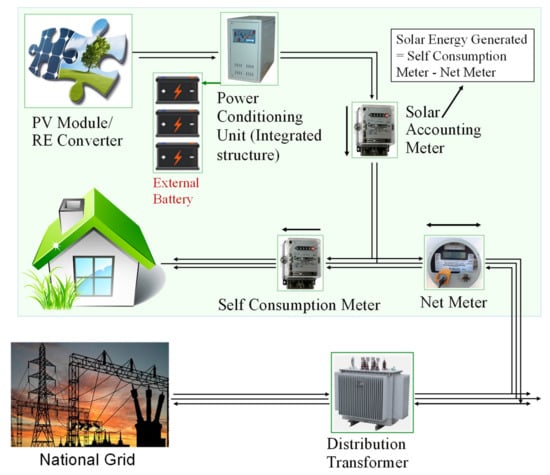
Figure 13.
Typical net metering arrangement (authors’ creation based on ref. [75]).
In July 2018, the Government circulated the NEM standard to allocate rooftop solar electricity added to the grid. To progress this, in 2019, the GoB, SREDA, and SOLshare commenced a test scheme that connected electricity to new families. Furthermore, Grameen Shakti and SOLshare have been mounting peer-to-peer electricity exchange networks [76].
The GoB of Bangladesh has already fulfilled the target of installing 116 systems (capacity 39.53 MW) of decentralized Rooftop Solar Except Net Metering and 1270 systems (capacity 23.027 MW) of Net Metering Rooftop Solar, as shown in Table 5 and Figure 10. The government is also encouraging industries to set up solar PV to balance a portion of their energy demand from rooftop solar energy. The historical yearly net installed capacities of solar rooftops are shown in Figure 14. The implementing agencies of solar rooftops are BPDB, IDCOL, BREB, DPDC, DESCO, WZPDCL, SREDA, ASPCL, and RPCL.

Figure 14.
Historical yearly net installed capacity of on-grid and off-grid solar rooftops (authors’ creation based on SREDA data [21]).
5.3. Solar Irrigation
Bangladesh is an agro-based country, and agriculture is one of the major sectors behind the economic growth of the country [77]. Approximately two-thirds of the total population is directly or indirectly involved in agriculture [42]. In 2019, the share of agriculture in the GDP was 13.32% [48]. Because of the tropical to sub-tropical location of the country, irrigation plays a vital role in agriculture [78]. Currently, 1.34 million diesel driven water pumps are running for irrigation purposes, and spending on petroleum costs more than USD 1 billion yearly [79]. Solar-based irrigation is cheap and more eco-friendly than conventional diesel-based irrigation systems [43]. It enables farmers to improve crop yields and can ensure food security. That is why the GoB has devised a plan to install solar-based irrigation to reduce the fuel cost as well as to reduce greenhouse gas emissions [80]. It is noted that floods have occurred more frequently in Bangladesh [81] during the monsoon season, which could affect the safety and performance of solar PV. To avoid the flood risk, solar components should be installed above the flood water level.
In Bangladesh, approximately 6000 farmers now trust solar irrigation pumps, which are eco-friendly, greener, cleaner, and cheaper than diesel-based pumps. Already, the country has installed 2014 solar irrigation pumps, which have a combined electricity generation capacity of 44.338 MW per hour, and approximately 96 pumps with a capacity of 3.796 MW are under the ongoing implementation phase, as shown in Table 5 and Figure 10 and Figure 11. The historical yearly net installed capacity of solar irrigation in Bangladesh is shown in Figure 15. A token photograph of solar irrigation in Bangladesh is shown in Figure S3.
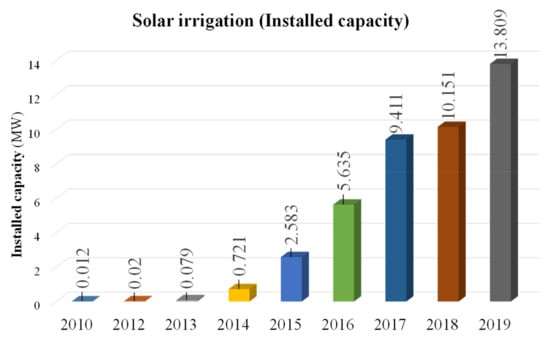
Figure 15.
Historical yearly net installed capacity of solar irrigation in Bangladesh (2010–2019) (authors’ creation based on SREDA data [21]).
5.4. Solar Mini-Grids, Solar Micro-Grids, Solar Nano-Grids, and Solar Pico-Grids
Though SHSs are successful in rural and remote areas where grid connection is not possible, the demand is more focused on grid-like quality power to run fans, fridges, small shops, small manufacturing systems, and small and medium-sized enterprises, i.e., rice mills, oil mills, spices mill, etc., which enforces the need to discover a reliable electricity system. Moreover, poor people use electricity for lighting purposes only, but middle-income people have more demand for operating fridges, fans, televisions, and charging batteries [44]. That is why the GoB has attempted to expand solar mini-grid, micro-grid, nano-grid, and pico-grid projects that provide electricity to domestic and mini-commercial users to encourage commercial activities in remote locations. The definitions for solar mini-grids, micro-grids, and nano-grids are provided in Table 7.

Table 7.
Definition of RE-based mini-grids, micro-grids, nano-grids, and pico-grids [82].
In Monpura island of Bangladesh, the SREDA, UNDP, and the GEF have successfully installed solar mini-grids under IDCOL’s mini-grid projects, and about 1199 households are experiencing this electricity [83]. The token snapshot of the solar mini-grid is shown in Figure S4 [83].
So far, 27 solar mini-grids and 2 solar nano-grids with a cumulative capacity of 5.656 MW and 0.001 MW have been installed and are currently running, and micro-grid and pico-grid projects are planned for the future. Twenty-six mini-grids with a cumulative generation capacity of 5 MW are being financed by IDCOL for approximately 16,000 beneficiaries in rural Bangladesh, also contributing an estimated 29,300 tons of CO2 reduction during the project lifetime [84]. Although BPDB has installed the largest solar mini-grid project in south Asia, there is also a 650kW project known as the solar mini-grid project at Sullah in the Sunamganj district, financed by the Climate Change Trust Fund (CCTF). The historical yearly net installed capacity of solar mini-grids and nano-grids in Bangladesh is shown in Figure 16.
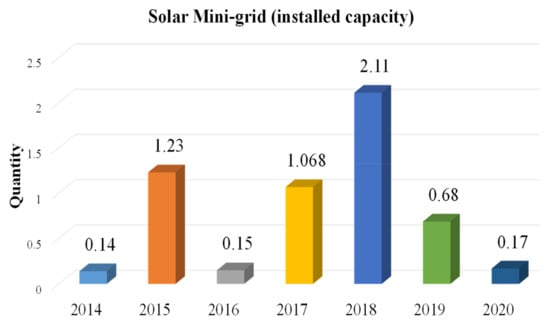
Figure 16.
Historical yearly net installed capacity of solar mini-grids and nano-grids in Bangladesh (authors’ creation based on SREDA data [21]).
5.5. Solar Charging Stations
In Bangladesh, there are a lot of environmentally friendly, battery-operated, and energy efficient three-wheelers, locally called Easy-bikes/Auto-rikshaw [85]. Most of them are regularly charged dishonestly from the 11 KV grid-connected electricity networks. Solar charging stations are an alternative to decrease the burden on grid electricity. The government has already installed 14 solar charging stations with a cumulative capacity of 0.282 MW, and more charging stations are on their way to be set up all over the country, as shown in Figure 10. The historical yearly net installed capacity of solar charging stations in Bangladesh is shown in Figure 17.
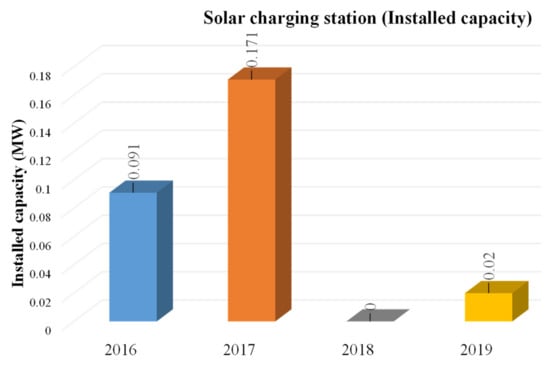
Figure 17.
Historical yearly net installed capacity of solar charging stations in Bangladesh (authors’ creation based on SREDA data [21]).
Figure 18 shows a tri-directional energy flow. During sunny days, RE, generated by solar panels, charge the vehicles nonstop and surplus energy is stored in a rechargeable storage battery for nighttime use. During the night, the storage battery automatically switches the energy to the vehicle and other purposes. When the weather condition is not favorable and the battery storage is inadequate, the system automatically switches the energy to the vehicle from the main grid.


Figure 18.
A tri-directional energy flow of solar energy at solar charging stations: (a) directly charges the vehicle during day time, (b) the system automatically switches to energy from the storage batteries during night time, and (c) during bad weather condition, if the battery capacity is insufficient, the system automatically switches to energy from the main grid. [86].
5.6. Solar Powered Telecom BTS
A solar-powered telecom system is a system of providing electricity to telecommunication systems in remote areas that are far from the national grid, for example, chars and bars of the river, hilltops, coastal/offshore areas, etc., where electricity is not available or where it is neither possible nor viable to connect new power lines [87]. In remote areas, solar-powered telecom systems allow rural people to access solar power to charge their batteries and use mobile phones, TVs, and radios [88].
In Bangladesh, more than one-fourth of the rural population lives without grid electricity [45]. In rural, remote, hilly, or char (river bar) areas where grid electricity is insufficient or poor people are not capable of taking grid lines, solar energy is the best option to charge their mobile phones.
5.7. Solar Home Systems (SHS)
Solar home systems (SHSs) are globally recognized photovoltaic systems that are used to meet the demand for electricity, especially for rural off-grid households [89]. Currently, students can study at nighttime, village shops can open for a long time at night, and people can charge and access mobile phones at all times in rural Bangladesh due to the installation of solar home systems [58]. In 2003, with the assistance of the World Bank, IDCOL launched the SHS project with the aim of offering finance to several partner organizations for offering loans and collecting installments from customers who are not capable of installing solar panels with self-finance [89]. The main objective of installing SHS is to provide clean and green electricity to off-grid rural households with the aim of achieving the vision for 2021 with a goal of 100% electrification in Bangladesh by 2020 [65].
With a view to developing the biggest off-grid RE platform in the world, the GoB has already installed around 6 million (6,023,631) SHSs in the off-grid zones of Bangladesh in July 2020, and approximately 20 million rural people have benefited from these SHSs, roughly one-eighth of the total population [22]. The cumulative generation capacity of these SHS is close to 262.55 MW, as shown in Figure 19. The historical installed capacity of solar home systems is shown in Figure 20.
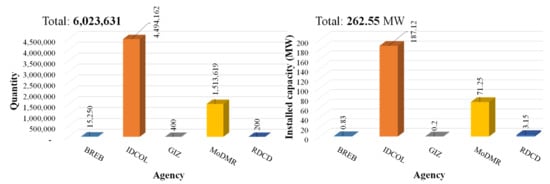
Figure 19.
Quantity and installed capacity of solar home systems (SHSs) (authors’ creation based on SREDA data [21]).

Figure 20.
The historical installed quantity and capacity of solar home systems (2011-2019) (authors’ creation based on SREDA data [21]).
As the installation of SHS is costly, it becomes commercially competitive at an early stage [46]. However, now it is gradually becoming popular in remote areas due to subsidizing schemes and favorable policies undertaken by the government and other stakeholders such as BREB, IDCOL, GIZ, MoDMR, RDCD, etc. where IDCOL and MoDMR have the largest share, as shown in Figure 19. Approximately 70,000 jobs have been opened through SHS projects, and the country is saving approximately USD 225 million, which substitutes 180,000 tons of kerosene every year [90]. Previously, rural people used conventional kerosene lamps at night, but now they no longer have to rely on kerosene and polluting firewood. Girls and boys can now progress their literacy levels by studying at night.
5.8. Solar Street Light
Solar street light is a solar-based lighting system with a view to lighting the road. These lights are independent utility grids of non-polluting environmentally friendly electricity sources for both urban as well as rural off-grid areas and hold minimum operation costs. Currently, many countries are using smart solar-powered street lighting, such as Brazil [91], Japan, etc. [92]. In Bangladesh, a total of 296,061 solar street lights with a capacity of 16.7 MW have been installed by MoCHTA and MoDMR, as shown in Figure 10. Several other private organizations also installed solar street lights, which are not included here. The historical installed capacities of solar street lights are shown in Figure 21. The statistics on installed solar street lights in Bangladesh are shown in Table 8.

Table 8.
Statistics of installed solar street lights (authors’ creation based on SREDA data [21]).

Figure 21.
The historical installed quantity and installed capacity of solar street lights (2017–2020) (authors’ creation based on SREDA data [21]).
5.9. Solar Drinking Water
In the southern region of Bangladesh, drinking water is scarce due to saline water intrusion from the Bay of Bengal. In the northern high altitude and southern coastal portion of Bangladesh, solar-based water desalination units have high potential. In Bangladesh, a total of 296,061 solar drinking water systems with a capacity of 0.095 MW have been installed, as shown in Figure 10. The historical installed capacities of solar drinking water systems are shown in Figure 22.

Figure 22.
The historical installed capacity of solar drinking water (2010–2014) (authors’ creation based on SREDA data [21]).
Furthermore, the GoB have taken initiative for the installation of approximately 1140 solar-based water desalination units to ensure pure drinking water, which will provide safe drinking water to roughly 30,000 people in 16 seaside saline-prone districts of Bangladesh [93].
6. Eco-Friendly Energy Source and Sustainability
As we know, roughly 75% of global energy is generated by the burning of fossil fuels that emit a lot of greenhouse gases, especially CO2, into the atmosphere, leading to unsustainable developments [94]. Most importantly, in recent times, the number of coal-based power plants in Bangladesh has dramatically increased along with other industrial activities, which may harm the local environment [95]. Bangladesh is already in a potential hazardous region in the context of climate change issues such as sea level rise in coastal areas and severe drought in northern Bangladesh because of these greenhouse gases [96]. Moreover, these gases also disturb the biodiversity and other components of natural habitats. Solar energy is an eco-friendly energy source because it reduces CO2 gas emission.
CO2 Emission Reduction
In FY 2020–21, the total yearly net energy generation in Bangladesh was 80,423 GWh, in which 76,609 GW of electricity was generated from conventional nonrenewable energy sources and 813 GW from RE sources [24]. Electricity generated from conventional nonrenewable energy sources includes 48,403 GW from natural gas, 17,497 GW from furnace oil, 609 GW from diesel, 4997 GW from coal, and 8103 GW from power imported from India (generated from coal [97]), as shown in Table 9.

Table 9.
Total net energy generation of Bangladesh in FY 2020–21 (authors’ creation based on ref. [24]).
Carbon dioxide emissions from primary energy use (for electricity generation by nonrenewable energy sources of Bangladesh) are estimated by applying the consumption of each energy source type (coal, natural gas, and various oil products) by multiplying the IPCC’s “Carbon dioxide Emissions Factors” [98]. In Bangladesh, the total yearly (FY 2020–21) net carbon dioxide emissions from electricity generation by nonrenewable energy sources (i.e., natural gas, furnace oil, diesel, and coal) was about 18,785,553 tons, in which 9,621,115 tons of CO2 were emitted from the combustion of natural gas, 4,544,032 tons of CO2 were emitted from furnace oil, 159,892 tons of CO2 were emitted from diesel, and 4,460,515 tons of CO2 were emitted from coal. It should be noted that approximately 8103 GWh of power generated from the burning of coal was imported from India, as shown in Table 10.

Table 10.
CO2 emission from electricity generation by nonrenewable energy sources of Bangladesh in FY 2020–21 (authors’ creation based on [99]).
Renewable energies may resolve this impending calamitous situation, conserve the local environment, and act as a subsidy to meet the current and future demand for electricity in Bangladesh. Bangladesh could add RE to generate electricity along with the conventional nonrenewable fossil fuel sources to contribute to carbon dioxide emission reduction and climate change mitigation and thus contribute to combating climate change [100,101]. Moreover, PV energy would be a key step in creating a bright future for Bangladesh and would:
- produce green, clean, and safe electric power to meet the energy needs of the country;
- generate large-scale solar power similar to natural gas-based electricity generation stations by installing large-scale solar parks;
- sell excess solar electricity and generate a side income source by installing Net Energy Metering (NEM) systems;
- generate solar-based irrigation, which is cheap and safe for the environment compared to conventional fuel-based irrigation systems;
- be a source of electricity production in remote areas by installing solar grid systems (mini, micro, pico, and nano-grids);
- be a nonstop charging station for vehicles, and surplus energy can be stored in rechargeable storage batteries for nighttime use;
- be a source of charging telecommunication systems such as mobile phones, TVs, radios, etc., in remote areas such as chars and bars of rivers, hilltops, coastal/offshore areas, etc.;
- be a source of green electricity to the off-grid rural households by installing SHS;
- be a source of street lighting for both urban as well as rural off-grid areas;
- be a source of solar-based drinking water desalination units by installing solar-based drinking water plants in coastal saline water intrusion areas;
- facilitate the planning of new transmission lines and provide jobs in rural and remote areas;
- diversify the country’s economy and provide more tax revenue.
Solar energy has the highest potential among all other renewable resources since solar energy can be used in various forms such as solar parks, solar rooftops, solar irrigation, solar charging stations, solar home systems, solar-powered telecom BTS, solar street lights, and solar drinking water, as discussed earlier. Therefore, energy from renewable solar sources could lead to an energy solution for Bangladesh in a sustainable way and also ensure an eco-friendly society/habitat in future.
7. Conclusions
Since fossil fuels are depleting fast, solar energy technologies have become popular all over the globe. Currently, several new forms of large and small solar power projects are ongoing to achieve SDGs and the GoB vision of 2041. The GoB vision aims to complete the renewable energy target to meet 10% and 100% of the total power demand by 2020 and 2050 and improve the renewable energy sector as part of the power generation program.
To decrease addiction to fossil fuels for power generation, the GoB has already started grid-connected solar park’ projects where no battery back-up is desired. To utilize the roofs of buildings, the government has initiated the development of solar rooftops as most of the building’s roofs are either fully or partially vacant. As Bangladesh is an agro-based country, the GoB has installed 2014 solar irrigation pumps with a capacity of 44.338 MW per hour to reduce fuel costs. Farmers now trust solar irrigation pumps, which are eco-friendly, greener, cleaner, and cheaper than diesel-based pumps. This enables farmers to ensure food security. The GoB has already installed approximately 6 million SHSs in the off-grid areas of Bangladesh, and roughly 20 million rural people are benefiting from this. To run small and medium-sized enterprises, i.e., rice mills, oil mills, spice mills, etc., the GoB has already installed solar mini-grids and nano-grids that provide electricity to domestic and mini-profitmaking users to inspire commercial activities in remote regions. Solar micro-grid and pico-grid projects are in the planning phase. The GoB has also installed solar power charging stations to charge battery-operated three-wheelers. These stations are eco-friendly and decrease the burden on the national grid electricity of the country. The government has also installed solar-powered telecom BTS for charging mobile phones for the people of rural, remote, hilly, or char (river bar) areas where grid electricity is insufficient or where poor people are not capable of using a grid line. The government has also installed a solar pump for drinking water for the people of the southern region of Bangladesh, where drinking water is scarce due to saline water intrusion from the Bay of Bengal.
Bangladesh’s conventional nonrenewable energy sources may not be viable in the future, considering rising fuel costs, limited resources, and environmental prospects. Installing solar energy in different forms to fulfil other purposes such as SHS, irrigation, battery charging, street lighting, pumps for drinking water, etc., would be the future generation’s energy source in Bangladesh and could enrich the sustainability of the country.
Supplementary Materials
The following supporting information can be downloaded at: https://www.mdpi.com/article/10.3390/en15186790/s1, Figure S1: Historical global renewable generation capacity by energy (2010–2019) [51]; Figure S2: Gauripur solar park, Mymensingh, Bangladesh [73]; Figure S3: Solar irrigation project in Bangladesh [80]; Figure S4: Solar mini-grid in Monpura island of Bangladesh [83].
Author Contributions
M.A.-A.-M. and A.R.M.T.I., designed, conceptualized, and drafted the original manuscript; M.A.-A.-M. and A.R.M.T.I., planned the documents; M.A.-A.-M., A.R.M.T.I. and H.G.A., were involved in the literature review, software, mapping, statistical analysis, interpretation of the analysis, and discussion; M.A.-A.-M., A.R.M.T.I., H.A. and H.G.A., contributed to instrumental setup and data analysis; M.A.-A.-M., H.G.A., H.A., A.A.A.D., M.A.-M. and A.R.M.T.I., contributed to data collection and extraction; M.A.-A.-M., H.G.A., H.A., A.A.A.D., M.A.-M. and A.R.M.T.I., conducted the internal review and proofreading during the manuscript drafting stage. M.A.-M., H.A., A.A.A.D. and H.G.A., are responsible for funding acquisition. All authors have read and agreed to the published version of the manuscript.
Funding
The article processing charge was funded by the Deanship of Scientific Research, Qassim University.
Data Availability Statement
The data presented in this study are available on request from H.A. and the corresponding author.
Acknowledgments
The researchers would like to thank the Deanship of Scientific Research, Qassim University, for funding the publication of this project. We would like to thank the Sustainable and Renewable Energy Development Authority (SREDA), BMD, and GoB, who cordially provided the renewable data of Bangladesh. We would also like to thank the International Renewable Energy Agency (IRENA), Renewable Energy Policy Network for the 21st Century (Ren21), Bangladesh Bureau of Statistics (BBS), and Bangladesh Power Development Board (BPThe article processing charge was funded by the Deanship of Scientific Research, Qassim UniversityDB) for providing yearly updated data.
Conflicts of Interest
The authors declare no conflict of interest.
References
- Mondal, M.A.H.; Denich, M. Assessment of Renewable Energy Resources Potential for Electricity Generation in Bangladesh. Renew. Sustain. Energy Rev. 2010, 14, 2401–2413. [Google Scholar] [CrossRef]
- Gulagi, A.; Choudhary, P.; Bogdanov, D.; Breyer, C. Electricity System Based on 100% Renewable Energy for India and SAARC. PLoS ONE 2017, 12, e0180611. [Google Scholar] [CrossRef]
- Bagalini, V.; Zhao, B.Y.; Wang, R.Z.; Desideri, U. Solar PV-Battery-Electric Grid-Based Energy System for Residential Applications: System Configuration and Viability. Research 2019, 2019, 3838603. [Google Scholar] [CrossRef]
- Asif, M.; Muneer, T. Energy Supply, Its Demand and Security Issues for Developed and Emerging Economies. Renew. Sustain. Energy Rev. 2007, 11, 1388–1413. [Google Scholar] [CrossRef]
- Halder, P.K.; Paul, N.; Joardder, M.U.H.; Sarker, M. Energy Scarcity and Potential of Renewable Energy in Bangladesh. Renew. Sustain. Energy Rev. 2015, 51, 1636–1649. [Google Scholar] [CrossRef]
- Ahmed, S.; Islam, M.T.; Karim, M.A.; Karim, N.M. Exploitation of Renewable Energy for Sustainable Development and Overcoming Power Crisis in Bangladesh. Renew. Energy 2014, 72, 223–235. [Google Scholar] [CrossRef]
- Grammelis, P.; Margaritis, N.; Karampinis, E. Solid Fuel Types for Energy Generation. In Fuel Flexible Energy Generation; Elsevier: Amsterdam, The Netherlands, 2016; pp. 29–58. ISBN 978-1-78242-378-2. [Google Scholar]
- Ahiduzzaman, M.; Islam, A.K.M.S. Greenhouse Gas Emission and Renewable Energy Sources for Sustainable Development in Bangladesh. Renew. Sustain. Energy Rev. 2011, 15, 4659–4666. [Google Scholar] [CrossRef]
- Yüksel, I. Global Warming and Renewable Energy Sources for Sustainable Development in Turkey. Renew. Energy 2008, 33, 802–812. [Google Scholar] [CrossRef]
- Al-tabatabaie, K.F.; Hossain, M.B.; Islam, M.K.; Awual, M.R.; TowfiqulIslam, A.R.M.; Hossain, M.A.; Esraz-Ul-Zannat, M.; Islam, A. Taking Strides towards Decarbonization: The Viewpoint of Bangladesh. Energy Strategy Rev. 2022, 44, 100948. [Google Scholar] [CrossRef]
- Shezan, S.K.A.; Ping, H.W. Techno-Economic and Feasibility Analysis of a Hybrid PV-Wind-Biomass- Diesel Energy System for Sustainable Development at Offshore Areas in Bangladesh. CAE 2017, 1, 20–32. [Google Scholar] [CrossRef]
- Zafar, U.; Ur Rashid, T.; Khosa, A.A.; Khalil, M.S.; Rashid, M. An Overview of Implemented Renewable Energy Policy of Pakistan. Renew. Sustain. Energy Rev. 2018, 82, 654–665. [Google Scholar] [CrossRef]
- REN21. Renewables 2020 Global Status Report. 2020. Available online: https://www.ren21.net/wp-content/uploads/2019/05/gsr_2020_full_report_en.pdf (accessed on 26 May 2022).
- Islam, A.K.M.S.; Islam, M.; Rahman, T. Effective Renewable Energy Activities in Bangladesh. Renew. Energy 2006, 31, 677–688. [Google Scholar] [CrossRef]
- Kabir, K.; Uddin, M. Prospects of Renewable Energy at Rural Areas in Bangladesh: Policy Analysis. J. Environ. Sci. Nat. Resour. 2015, 8, 105–113. [Google Scholar] [CrossRef][Green Version]
- Kiwan, S.; Abo Mosali, A.; Al-Ghasem, A. Smart Solar-Powered LED Outdoor Lighting System Based on the Energy Storage Level in Batteries. Buildings 2018, 8, 119. [Google Scholar] [CrossRef]
- Bangladesh Population (LIVE). World Population Review. 2021. Available online: https://worldpopulationreview.com/countries/bangladesh-population/ (accessed on 27 March 2021).
- Bangladesh Population (LIVE). Worldometers. 2021. Available online: https://www.worldometers.info/world-population/bangladesh-population/ (accessed on 27 March 2021).
- Bangladesh Statistics 2017. Bangladesh Bureau of Statistics (BBS), Statistics and Informatics Division (SID) Ministry of Planning. Available online: https://bbs.portal.gov.bd/sites/default/files/files/bbs.portal.gov.bd/page/a1d32f13_8553_44f1_92e6_8ff80a4ff82e/Bangladesh%20%20Statistics-2017.pdf (accessed on 21 May 2022).
- Islam, S.; Khan, M.Z.R. A Review of Energy Sector of Bangladesh. Energy Procedia 2017, 110, 611–618. [Google Scholar] [CrossRef]
- Sustainable and Renewable Energy Development Authority (SREDA). Ministry of Power, Mineral and Energy Resources, Bangladesh. Available online: https://solar.sreda.gov.bd/ (accessed on 30 March 2021).
- Weforum. Life for Millions in Bangladesh is Being Transformed Thanks to This Simple Solution. 2020. Available online: https://www.weforum.org/agenda/2020/01/bangladesh-solar-power-energy-grid-rural-life/ (accessed on 15 June 2020).
- BPDB. Annual Report 2019–2020 of Bangladesh Power Development Board (BPDB). 2020. Available online: http://119.40.95.168/bpdb/resourcefile/annualreports/annualreport_1605772936_AnnualReport2019-20.pdf (accessed on 10 January 2022).
- BPDB. Annual Report 2020–2021 of Bangladesh Power Development Board (BPDB). 2021. Available online: http://119.40.95.168/bpdb/resourcefile/annualreports/annualreport_1657015763_Annual_Report_2020-2021_(4).pdf (accessed on 10 January 2022).
- Powerdivision. Revisiting PSMP 2016. Available online: https://powerdivision.portal.gov.bd/sites/default/files/files/powerdivision.portal.gov.bd/page/4f81bf4d_1180_4c53_b27c_8fa0eb11e2c1/Revisiting%20PSMP2016%20%28full%20report%29_signed.pdf (accessed on 21 April 2022).
- Hydrocarb Unit, Energy and Mineral Resources Division, Ministry of Power, Energy and Mineral Resources, Government of People’s Republic Bangladesh. Hydrocarb Unit Energy Scenario Bangladesh 2019–20. 2021. Available online: https://hcu.portal.gov.bd/sites/default/files/files/hcu.portal.gov.bd/publications/753d455d_3c37_43df_9ce6_6f80bdc0e982/2021-03-16-11-10-66fbccf16c104e594c24f303097aa65f.pdf (accessed on 21 April 2022).
- BPDB. Annual Report 2018–2019 of Bangladesh Power Development Board (BPDB) 2019. Available online: http://119.40.95.168/bpdb/resourcefile/annualreports/annualreport_1635135962_Annual_Report_2018-19.pdf (accessed on 10 January 2022).
- Statistical Pocketbook 2019. Bangladesh Bureau of Statistics Statistics and Informatics Division Ministry of Planning. Government of the People’s Republic of Bangladesh. Available online: https://bbs.portal.gov.bd/sites/default/files/files/bbs.portal.gov.bd/page/d6556cd1_dc6f_41f5_a766_042b69cb1687/2020-05-20-11-49-1f4b467955de85be60941c27650e3f66.pdf (accessed on 21 May 2022).
- Steelmintevents. Bangladesh to Add 17,304 MW Power Capacity to Meet Its Energy Requirement. Available online: https://www.steelmintevents.com/blog/bangladesh-to-add-17304-mw-power-capacity-to-meet-its-energy-requirement/ (accessed on 17 June 2020).
- Tbsnews. Power Sector Headed for Financial Disaster Due to Overcapacity in Coal and LNG Power: Study. Available online: https://tbsnews.net/bangladesh/energy/power-sector-headed-financial-disaster-due-overcapacity-coal-and-lng-power-study (accessed on 17 June 2020).
- International Energy Agency (IEA). Access to Electricity. Available online: https://www.iea.org/reports/sdg7-data-and-projections/access-to-electricity (accessed on 21 December 2021).
- Taheruzzaman, M.; Janik, P. Electric Energy Access in Bangladesh. TEEE 2016, 1, 6–17. [Google Scholar] [CrossRef]
- Islam, M.Z.; Shameem, R.; Mashsharat, A.; Mim, M.S.; Rafy, M.F.; Pervej, M.S.; Rahman Ahad, M.A. A Study of Solar Home System in Bangladesh: Current Status, Future Prospect and Constraints. In Proceedings of the 2nd International Conference on Green Energy and Technology, Dhaka, Bangladesh, 5–6 September 2014; pp. 110–115. [Google Scholar]
- Mozumder, P.; Marathe, A. Causality Relationship between Electricity Consumption and GDP in Bangladesh. Energy Policy 2007, 35, 395–402. [Google Scholar] [CrossRef]
- General Economics Division (GED) Bangladesh Planning Commission Ministry of Planning Government of the People’s Republic of Bangladesh. Making Vision 2041 a Reality Perspective Plan of Bangladesh 2021–2041. 2021. Available online: https://www.startupbangladesh.vc/wp-content/uploads/2021/06/Perspective-plan-of-Bangladesh-2021-2041.pdf (accessed on 19 August 2022).
- Jacobson, A. Connective Power: Solar Electrification and Social Change in Kenya. World Dev. 2007, 35, 144–162. [Google Scholar] [CrossRef]
- Jakhongir Turakul Ugli, T. The Importance of Alternative Solar Energy Sources and the Advantages and Disadvantages of Using Solar Panels in This Process. AJSEA 2019, 8, 32. [Google Scholar] [CrossRef]
- Dinçer, F. The Analysis on Photovoltaic Electricity Generation Status, Potential and Policies of the Leading Countries in Solar Energy. Renew. Sustain. Energy Rev. 2011, 15, 713–720. [Google Scholar] [CrossRef]
- Shaikh, M.R.S. A Review Paper on Electricity Generation from Solar Energy. IJRASET 2017, 5, 1884–1889. [Google Scholar] [CrossRef]
- Amin, A.; Sultana, A.; Hasan, J.; Islam, M.T.; Khan, F. Solar Home System in Bangladesh: Prospects, Challenges and Constraints. In Proceedings of the 2014 3rd International Conference on the Developments in Renewable Energy Technology (ICDRET), Dhaka, Bangladesh, 29–31 May 2014; pp. 1–5. [Google Scholar] [CrossRef]
- Rofiqul Islam, M.; Rabiul Islam, M.; Rafiqul Alam Beg, M. Renewable Energy Resources and Technologies Practice in Bangladesh. Renew. Sustain. Energy Rev. 2008, 12, 299–343. [Google Scholar] [CrossRef]
- Islam, M.R.; Sarker, P.C.; Ghosh, S.K. Prospect and Advancement of Solar Irrigation in Bangladesh: A Review. Renew. Sustain. Energy Rev. 2017, 77, 406–422. [Google Scholar] [CrossRef]
- Hossain, M.A.; Hassan, M.S.; Mottalib, M.A.; Ahmmed, S. Technical and Economic Feasibility of Solar Pump Irrigations for Eco-Friendly Environment. Procedia Eng. 2015, 105, 670–678. [Google Scholar] [CrossRef]
- Bhattacharyya, S.C. Mini-Grid Based Electrification in Bangladesh: Technical Configuration and Business Analysis. Renew. Energy 2015, 75, 745–761. [Google Scholar] [CrossRef]
- Chowdhury, S.A.; Mourshed, M.; Kabir, S.M.R.; Islam, M.; Morshed, T.; Khan, M.R.; Patwary, M.N. Technical Appraisal of Solar Home Systems in Bangladesh: A Field Investigation. Renew. Energy 2011, 36, 772–778. [Google Scholar] [CrossRef]
- Najmul Hoque, S.M.; Kumar Das, B. Present Status of Solar Home and Photovoltaic Micro Utility Systems in Bangladesh and Recommendation for Further Expansion and Upgrading for Rural Electrification. J. Renew. Sustain. Energy 2013, 5, 042301. [Google Scholar] [CrossRef]
- Bangladesh Bureau of Statistics (BBS). 2016 Statistical Year Book Bangladesh = Bāṃlādeśa Parisaṃkhyāna Barshagrantha, 2016, 36th ed.; Bangladesh Bureau of Statistics: Dhaka, Bangladesh; Statistics & Informatics Division (SID), Ministry of Planning, Government of the People’s Republic of Bangladesh: Dhaka, Bangladesh, 2017; ISBN 978-984-519-090-9. Available online: http://bbs.portal.gov.bd/sites/default/files/files/bbs.portal.gov.bd/page/b2db8758_8497_412c_a9ec_6bb299f8b3ab/StatisticalYearBookFinal2016.pdf (accessed on 24 May 2022).
- Bangladesh Bureau of Statistics (BBS). Gross Domestic Product (GDP) of Bangladesh 2018–19. pp. 1–10. 2019. Available online: http://bbs.portal.gov.bd/sites/default/files/files/bbs.portal.gov.bd/page/057b0f3b_a9e8_4fde_b3a6_6daec3853586/2019-12-12-11-55-26007214ee20f95f34bf0446aa81e646.pdf (accessed on 11 June 2022).
- World Energy Council. Energy Resources: Solar. World Energy Council 2013 World Energy Resour Solar. 2013, pp. 1–28. Available online: https://www.worldenergy.org/wp-content/uploads/2013/10/WER_2013_8_Solar_revised.pdf (accessed on 14 May 2021).
- Bangladesh Meteorological Department (BMD). Ministry of Defense of the Government of Bangladesh. Available online: https://live3.bmd.gov.bd/ (accessed on 11 June 2021).
- International Renewable Energy Agency (IRENA). Trends in Renewable Energy. Available online: https://www.irena.org/Statistics/View-Data-by-Topic/Capacity-and-Generation/Statistics-Time-Series (accessed on 12 July 2021).
- International Renewable Energy Agency (IRENA). Available online: https://www.irena.org/solar (accessed on 27 April 2021).
- Globalsolaratlas. Available online: https://globalsolaratlas.info/download/bangladesh (accessed on 29 June 2021).
- Gielen, D.; Boshell, F.; Saygin, D.; Bazilian, M.D.; Wagner, N.; Gorini, R. The Role of Renewable Energy in the Global Energy Transformation. Energy Strategy Rev. 2019, 24, 38–50. [Google Scholar] [CrossRef]
- Kusch-Brandt, S. Urban Renewable Energy on the Upswing: A Spotlight on Renewable Energy in Cities in REN21’s “Renewables 2019 Global Status Report”. Resources 2019, 8, 139. [Google Scholar] [CrossRef]
- Khan, N.; Kalair, A.; Abas, N.; Haider, A. Review of Ocean Tidal, Wave and Thermal Energy Technologies. Renew. Sustain. Energy Rev. 2017, 72, 590–604. [Google Scholar] [CrossRef]
- Abas, N.; Kalair, A.; Khan, N. Review of Fossil Fuels and Future Energy Technologies. Futures 2015, 69, 31–49. [Google Scholar] [CrossRef]
- Aljazeera. Bangladesh: One in Five People Live Below Poverty Line. Available online: https://www.aljazeera.com/news/2020/01/bangladesh-people-live-poverty-line-200126100532869.html (accessed on 21 January 2022).
- The World Bank. Bangladesh Poverty Assessment: Facing Old and New Frontiers in Poverty Reduction; The World Bank: Washington, DC, USA, 2019; pp. 1–83. [Google Scholar]
- Marro, P.; Bertsch, N. Making Renewable Energy a Success in Bangladesh: Getting the Business Model Right by Asian Development Bank; Asian Development Bank: Metro Manila, Philippines, 2015. [Google Scholar]
- Momotaz; Tanjinul, H.M.; Anannya, M.; Takaaki, N. Current Scenario and Challenges of Agricultural Production to Future Food Security in Bangladesh. J. Agric. Ext. Rural Dev. 2019, 11, 208–224. [Google Scholar] [CrossRef]
- Islam, H.M.T.; Islam, A.R.M.T.; Abdullah-Al-Mahbub, M.; Shahid, S.; Tasnuva, A.; Kamruzzaman, M.; Hu, Z.; Elbeltagi, A.; Kabir, M.M.; Salam, M.A.; et al. Spatiotemporal Changes and Modulations of Extreme Climatic Indices in Monsoon-Dominated Climate Region Linkage with Large-Scale Atmospheric Oscillation. Atmos. Res. 2021, 264, 105840. [Google Scholar] [CrossRef]
- Al Zaman, M.A.; Jahan Monira, N. A Study of Earthquakes in Bangladesh and the Data Analysis of the Earthquakes That Were Generated In Bangladesh and Its’ Very Close Regions for the Last Forty Years (1976–2016). J. Geol. Geophys. 2017, 6, 2. [Google Scholar] [CrossRef]
- Farukh, M.; Islam, M.; Akter, L.; Khatun, R. Trend and Variability Analysis of Sunshine Duration in Divisional Headquarters of Bangladesh. J. Environ. Sci. Nat. Resour. 2021, 12, 127–133. [Google Scholar] [CrossRef]
- Hossain, M.F.; Hossain, S.; Uddin, M.J. Renewable Energy: Prospects and Trends in Bangladesh. Renew. Sustain. Energy Rev. 2017, 70, 44–49. [Google Scholar] [CrossRef]
- Wazed, M.A.; Nukman, Y.; Islam, M.T. Design and Fabrication of a Cost Effective Solar Air Heater for Bangladesh. Appl. Energy 2010, 87, 3030–3036. [Google Scholar] [CrossRef]
- Woyte, A.; Goy, S. Large Grid-Connected Photovoltaic Power Plants. In The Performance of Photovoltaic (PV) Systems; Elsevier: Amsterdam, The Netherlands, 2017; pp. 321–337. ISBN 978-1-78242-336-2. [Google Scholar]
- de Simón-Martín, M.; Diez-Suárez, A.-M.; Álvarez-de Prado, L.; González-Martínez, A.; de la Puente-Gil, Á.; Blanes-Peiró, J. Development of a GIS Tool for High Precision PV Degradation Monitoring and Supervision: Feasibility Analysis in Large and Small PV Plants. Sustainability 2017, 9, 965. [Google Scholar] [CrossRef]
- Ventura, C.; Tina, G.M. Utility Scale Photovoltaic Plant Indices and Models for On-Line Monitoring and Fault Detection Purposes. Electr. Power Syst. Res. 2016, 136, 43–56. [Google Scholar] [CrossRef]
- Pv-Magazine. An Overview of the World’s Largest Solar Parks. 2019. Available online: https://www.pv-magazine.com/2019/06/11/an-overview-of-the-worlds-largest-solar-parks/ (accessed on 24 July 2021).
- Indianeconomy. What is Solar Park Project? 2016. Available online: https://www.indianeconomy.net/splclassroom/what-is-solar-park-project/ (accessed on 24 July 2021).
- Renewableenergyworld. What Is a Solar Farm. 2019. Available online: https://www.renewableenergyworld.com/2019/04/30/what-is-a-solar-farm/#gref (accessed on 24 July 2021).
- Bruce, L. The Largest Solar Power Plant in Bangladesh Connected to The Grid with Huawei PV Solution. Available online: https://solar.huawei.com/apac/news/apac/2020/10/The-largest-solar-power-plant-in-Bangladesh-connected-to-the-grid-with-Huawei-PV-Solution. (accessed on 7 May 2022).
- Zinaman, O.; Aznar, A.; Linvill, C.; Darghouth, N.; Dubbeling, T.; Bianco, E. Grid Connected Distributed Generation: Compensation Mechanism Basics; National Renew Energy Laboratory: Golden, CO, USA, 2017. [Google Scholar]
- Chowdhury, S.A. Guidelines for Net Energy Metering in Bangladesh Integrating Distributed Renewable Energy. 2017. Available online: https://reeep2.sreda.gov.bd/projects/Report%20(Net%20Metering%20Guideline)-%202017.10.22.pdf (accessed on 13 March 2022).
- Nextbillion. Solar, Expanded: Building the Future of Utilities in Bangladesh. 2019. Available online: https://nextbillion.net/solar-future-of-utilities-in-bangladesh/ (accessed on 9 March 2020).
- Rasha, R.K.; Liza, H.A.; Manjira, S.; Mizanul, M.; Kazal, H.; Rayhan, S.J. Financial profitability and resource use efficiency of boro rice production in some selected areas of Mymensingh district in Bangladesh. Res. Agric. Livest. Fisheries 2018, 5, 8. [Google Scholar] [CrossRef]
- Krupnik, T.J.; Schulthess, U.; Ahmed, Z.U.; McDonald, A.J. Sustainable Crop Intensification through Surface Water Irrigation in Bangladesh? A Geospatial Assessment of Landscape-Scale Production Potential. Land Use Policy 2017, 60, 206–222. [Google Scholar] [CrossRef] [PubMed]
- Tbsnews. Electricity, Solar Power Replacing Diesel in Irrigation. 2020. Available online: https://tbsnews.net/bangladesh/electricity-solar-power-replacing-diesel-irrigation (accessed on 7 September 2020).
- World Bank. Solar-powered Pumps Reduce Irrigation Costs in Bangladesh. Available online: https://www.worldbank.org/en/results/2015/09/08/solar-powered-pumps-reduce-irrigation-costs-bangladesh (accessed on 15 September 2020).
- Mia, M.U.; Rahman, M.; Elbeltagi, A.; Abdullah-Al-Mahbub, M.; Sharma, G.; Islam, H.M.T.; Pal, S.C.; Costache, R.; Islam, A.R.M.T.; Islam, M.M.; et al. Sustainable Flood Risk Assessment Using Deep Learning-Based Algorithms with a Blockchain Technology. Geocarto Int. 2022, 1–31. [Google Scholar] [CrossRef]
- Sustainable and Renewable Energy Development Authority (SREDA). Year Wise Generation of Solar Irrigation. Available online: https://www.sreda.gov.bd/index.php/site/page/8237-59ee-504b-dd46-c18b-d705-b93f-7d35-a046-1f95 (accessed on 15 September 2020).
- United Nations Development Programme (UNDP). Solar Mini-Grid Projects in Bangladesh. Available online: https://www.undp.org/press-releases/monpura-island-bangladesh-lights-solar-mini-grids (accessed on 17 June 2021).
- Infrastructure Development Company Limited (IDCOL). Available online: https://idcol.org/home/solar_min (accessed on 16 May 2021).
- Iqbal, M. Study on Merits and Demerits of Two Transport Systems: Battery Operated Easy Bike with CNG Operated Auto Rickshaw at Sylhet City in Bangladesh. IOSR-JMCE 2013, 5, 25–32. [Google Scholar] [CrossRef]
- Islam, N. Solar Powered Battery Charging Station. Available online: https://idcol.org/download/Solar%20Powered%20Battery%20Charging%20Station.pdf (accessed on 17 June 2021).
- Mrsolar. Telecom Solar Power Kits. Available online: https://www.mrsolar.com/telecom-solar-power-kits/ (accessed on 6 September 2022).
- Alsharif, M.; Kim, J. Optimal Solar Power System for Remote Telecommunication Base Stations: A Case Study Based on the Characteristics of South Korea’s Solar Radiation Exposure. Sustainability 2016, 8, 942. [Google Scholar] [CrossRef]
- The World Bank. Solar Home Systems Project. Available online: https://projects.worldbank.org/en/projects-operations/project-detail/P035544?lang=en (accessed on 13 June 2021).
- Masud, M.H.; Nuruzzaman, M.; Ahamed, R.; Ananno, A.A.; Tomal, A.N.M.A. Renewable Energy in Bangladesh: Current Situation and Future Prospect. Int. J. Sustain. Energy 2020, 39, 132–175. [Google Scholar] [CrossRef]
- Costa, M.A.D.; Costa, G.H. A high efficiency autonomous street lighting system based on solar energy and leds. In Proceedings of the 2009 Brazilian Power Electronics Conference, Bonito-Mato Grosso do Sul, Brazil, 27 September–1 October 2009. [Google Scholar] [CrossRef]
- Ministry of Electricity, National Energy Research Centre, Syrian Arab Republic. The Preparatory Survey on the Project for Solar Street Lighting System. 2010. Available online: https://openjicareport.jica.go.jp/pdf/12003612_01.pdf (accessed on 3 May 2022).
- Pv-Magazine. Solar Brings Safe Water to Bangladeshi Coastal Communities. Available online: https://www.pv-magazine.com/2020/02/14/solar-brings-safe-water-to-bangladeshi-coastal-communities/ (accessed on 17 July 2021).
- Sims, R.E.H.; Rogner, H.-H.; Gregory, K. Carbon Emission and Mitigation Cost Comparisons between Fossil Fuel, Nuclear and Renewable Energy Resources for Electricity Generation. Energy Policy 2003, 31, 1315–1326. [Google Scholar] [CrossRef]
- Climatechangenews. Bangladesh Scraps Nine Coal Power Plants as Overseas Finance Dries Up. 2021. Available online: https://www.climatechangenews.com/2021/02/25/bangladesh-scraps-nine-coal-power-plants-overseas-finance-dries/ (accessed on 9 March 2022).
- Selvaraju, R.; Baas, S. Climate Variability and Change: Adaptation to Drought in Bangladesh: A Resource Book and Training Guide; Institutions for Rural Development; Asian Disaster Preparedness Center, Food and Agriculture Organization of the United Nations: Rome, Italy, 2007; ISBN 978-92-5-105782-7. [Google Scholar]
- ‘Indian Plant Exporting Costly Coal Power to Bangladesh and Not Cheap Renewable Energy’ | The Daily Star. Available online: https://www.thedailystar.net/country/news/indian-plant-exporting-costly-coal-power-bangladesh-and-not-cheap-renewable-energy-1942737 (accessed on 17 March 2021).
- Our World in Data. Carbon Dioxide Emissions Factor, kg CO2 per MWh. Available online: https://ourworldindata.org/grapher/carbon-dioxide-emissions-factor (accessed on 7 May 2021).
- Eggleston, H.S.; Buendia, L.; Miwa, K.; Ngara, T.; Tanabe, K. (Eds.) 2006 IPCC Guidelines for National Greenhouse Gas Inventories; Prepared by the National Greenhouse Gas Inventories Programme; IGES: Kanagawa, Japan; Available online: https://www.ipcc-nggip.iges.or.jp/public/2006gl/vol2.html (accessed on 17 August 2021).
- Gastli, A.; Charabi, Y. Solar Electricity Prospects in Oman Using GIS-Based Solar Radiation Maps. Renew. Sustain. Energy Rev. 2010, 14, 790–797. [Google Scholar] [CrossRef]
- Halder, B.; Banik, P.; Almohamad, H.; Dughairi, A.A.A.; Al-Mutiry, M.; Shahrani, H.F.A.; Abdo, H.G. Land Suitability Investigation for Solar Power Plant Using GIS, AHP and Multi-Criteria Decision Approach: A Case of Megacity Kolkata, West Bengal, India. Sustainability 2022, 14, 11276. [Google Scholar] [CrossRef]
Publisher’s Note: MDPI stays neutral with regard to jurisdictional claims in published maps and institutional affiliations. |
© 2022 by the authors. Licensee MDPI, Basel, Switzerland. This article is an open access article distributed under the terms and conditions of the Creative Commons Attribution (CC BY) license (https://creativecommons.org/licenses/by/4.0/).